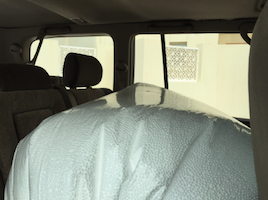I really liked the way I worked during this project. What made a huge difference was using the transferring technique and working with type on transparency sheets. It was like composing on the computer, but in real life. I learned a bunch of new tricks and techniques with this project.
For example:

Top: transfer using blending marker. Bottom: Transfer using nail polish remover plus marker on edges. Using a combination of both got me a well saturated image (polish remover) as well as with crisp details (marker)
I also experimented with scanning, and how different options when scanning can result in very different results. I ended using the regular 24-bit scans, because of the details and richness in colors:
Not only did this project help me practise working with my hands again, but my choice of topic was very fun for me. Creating a persona that I related to helped make a lot of my design choices. It also opened me up to shifting my topic, by thinking about what someone like me would be interested in seeing and doing. I tried out making jelly spheres/strawberry and banana caviar/ as a side experiment:



They were surprisingly successful, but ended up not making it into my zine. The reasoning behind this was also related to my persona. I thought about students like me, and how making simple foods for us/me is difficult or took time. That made my zine shift from an information book, to a mixture of entertaining foods, as well as the useful recipes part.

Finally, the composition of the final piece was very similar to working on inDesign. I had to test different typefaces and effects as always. What I found hard/inconvenient was having to keep on print different sizes of images, to test how it would look on the page. While working, resizing the image would be faster, easier on screen. But this way, it was better to be able to see the actual way the images would look, instead of having to test print.
This project didn’t really make me lean towards one way of working over the other. Both have their pros and cons. What I realised is that a balance of both would work for me better. Maybe collaging by hand, but resizing and composing on screen. Test prints are something that have to be done during both ways. It most likely would depend on project to project.


What was difficult was the alignment of crossovers by hand, since I really wanted to align some type across a spread. I ended up testing out registrations and stapling a certain way, to have the type be slightly off, but not so much that it’s illegible. What was also good to know—even though it was subconscious initially—was that I had kept a sense of narrative throughout the zine, despite it never being explicitly discussed (it should be obvious from the course’s name, but still).
















